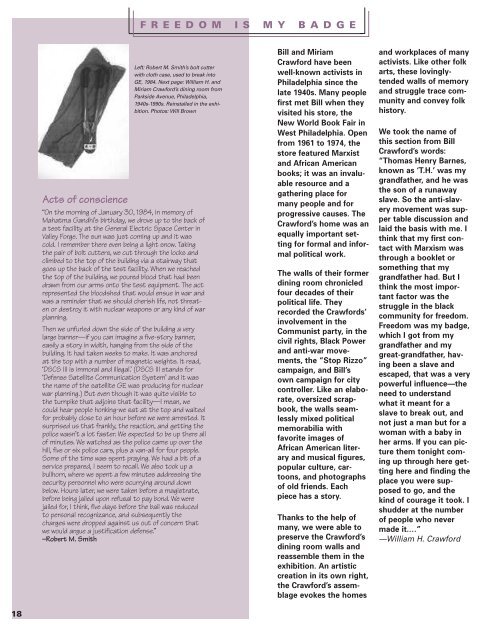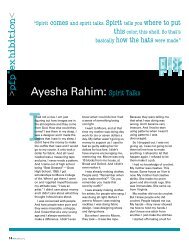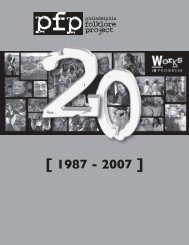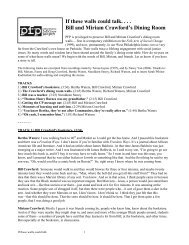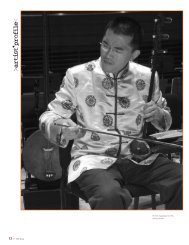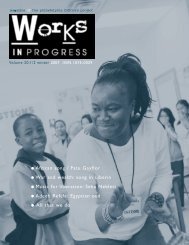View PDF - Philadelphia Folklore Project
View PDF - Philadelphia Folklore Project
View PDF - Philadelphia Folklore Project
You also want an ePaper? Increase the reach of your titles
YUMPU automatically turns print PDFs into web optimized ePapers that Google loves.
F R E E D O M I S M Y B A D G EF O L K A R T S O F S O C I A L C H A N G E E X H I B I T I O NLeft: Robert M. Smith’s bolt cutterwith cloth case, used to break intoGE, 1984. Next page: William H. andMiriam Crawford’s dining room fromParkside Avenue, <strong>Philadelphia</strong>,1940s-1990s. Reinstalled in the exhibition.Photos: Will BrownActs of conscience“On the morning of January 30, 1984, in memory ofMahatma Gandhi’s birthday, we drove up to the back ofa test facility at the General Electric Space Center inValley Forge. The sun was just coming up and it wascold. I remember there even being a light snow. Takingthe pair of bolt cutters, we cut through the locks andclimbed to the top of the building via a stairway thatgoes up the back of the test facility. When we reachedthe top of the building, we poured blood that had beendrawn from our arms onto the test equipment. The actrepresented the bloodshed that would ensue in war andwas a reminder that we should cherish life, not threatenor destroy it with nuclear weapons or any kind of warplanning.Then we unfurled down the side of the building a verylarge banner—if you can imagine a five-story banner,easily a story in width, hanging from the side of thebuilding. It had taken weeks to make. It was anchoredat the top with a number of magnetic weights. It read,‘DSCS III is immoral and illegal.’ (DSCS III stands for‘Defense Satellite Communication System’ and it wasthe name of the satellite GE was producing for nuclearwar planning.) But even though it was quite visible tothe turnpike that adjoins that facility—I mean, wecould hear people honking-we sat at the top and waitedfor probably close to an hour before we were arrested. Itsurprised us that frankly, the reaction, and getting thepolice wasn’t a lot faster. We expected to be up there allof minutes. We watched as the police came up over thehill, five or six police cars, plus a van-all for four people.Some of the time was spent praying. We had a bit of aservice prepared, I seem to recall. We also took up abullhorn, where we spent a few minutes addressing thesecurity personnel who were scurrying around downbelow. Hours later, we were taken before a magistrate,before being jailed upon refusal to pay bond. We werejailed for, I think, five days before the bail was reducedto personal recognizance, and subsequently thecharges were dropped against us out of concern thatwe would argue a justification defense.”–Robert M. SmithBill and MiriamCrawford have beenwell-known activists in<strong>Philadelphia</strong> since thelate 1940s. Many peoplefirst met Bill when theyvisited his store, theNew World Book Fair inWest <strong>Philadelphia</strong>. Openfrom 1961 to 1974, thestore featured Marxistand African Americanbooks; it was an invaluableresource and agathering place formany people and forprogressive causes. TheCrawford’s home was anequally important settingfor formal and informalpolitical work.The walls of their formerdining room chronicledfour decades of theirpolitical life. Theyrecorded the Crawfords’involvement in theCommunist party, in thecivil rights, Black Powerand anti-war movements,the “Stop Rizzo”campaign, and Bill’sown campaign for citycontroller. Like an elaborate,oversized scrapbook,the walls seamlesslymixed politicalmemorabilia withfavorite images ofAfrican American literaryand musical figures,popular culture, cartoons,and photographsof old friends. Eachpiece has a story.Thanks to the help ofmany, we were able topreserve the Crawford’sdining room walls andreassemble them in theexhibition. An artisticcreation in its own right,the Crawford’s assemblageevokes the homesand workplaces of manyactivists. Like other folkarts, these lovinglytendedwalls of memoryand struggle trace communityand convey folkhistory.We took the name ofthis section from BillCrawford’s words:“Thomas Henry Barnes,known as ‘T.H.’ was mygrandfather, and he wasthe son of a runawayslave. So the anti-slaverymovement was suppertable discussion andlaid the basis with me. Ithink that my first contactwith Marxism wasthrough a booklet orsomething that mygrandfather had. But Ithink the most importantfactor was thestruggle in the blackcommunity for freedom.Freedom was my badge,which I got from mygrandfather and mygreat-grandfather, havingbeen a slave andescaped, that was a verypowerful influence—theneed to understandwhat it meant for aslave to break out, andnot just a man but for awoman with a baby inher arms. If you can picturethem tonight comingup through here gettinghere and finding theplace you were supposedto go, and thekind of courage it took. Ishudder at the numberof people who nevermade it.…”—William H. Crawford(In the exhibition, we included thefollowing story, along with a missingpolaroid photograph from 1968, onceowned by Rafaela Colón, showing herin the suit described. Our labelexplained that sometimes objectsdon’t remain to document peoples’experiences, and in those cases,stories are important tools forkeeping memory alive.)Dignity Suits“When I graduated from high school, even though I hadtwo scholarships, I knew that my family could not affordfor me to go to college. So I started working. So I lookedfor a job, looked for a job. And finally found a job with theAmerican Friends Service Committee with the Quakers.Now, the reason I applied there, and I felt comfortable,because I thought it was the American Friendly ServiceCommittee. I used to make $1.91 an hour. My first checkwas fifty-seven dollars.I think the first time I felt that I had an inkling to strugglewas when I went to Blum’s, a really nice departmentstore, to buy an outfit. And I had tried on some clothes.And the woman said, ‘Who’s helping her?’ And the otherwoman said, ‘Don’t worry about it, she’s a spic, she’snot gonna buy anything.’ And I was the only one in thedressing room. Something just hurt. So I tried on thetwo suits. I had just gotten paid. I paid her. I told you—Imade like fifty-seven dollars a week. And each suit wasfifty dollars back then. It was 1967 or ‘68. I boughtboth suits. And I wrote a check. When I got home, mymother said, ‘We have to take them back.’ I told her, ‘Nomom, I have to buy them, I have to buy them.’ My momsaid, ‘Why?’ (My mom always told everybody this story.)I told mom, ‘Today I bought my dignity.’ And of course,you know, I was broke for the next two weeks. So I thinkthat was when I really noticed that things were different.Because, there was disparity, but I always thoughtit was because we were poor, that we couldn’t get thosethings, not because we were of color.”–Rafaela Colón18[Continued on p.20 ➝]19


